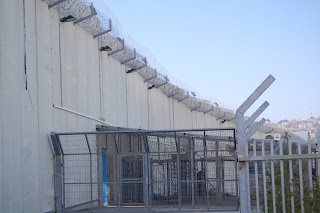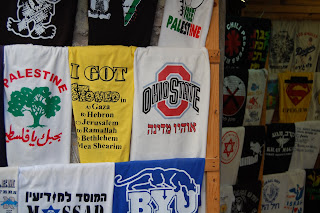After the Sea of Galilee and the Mediterranean (in Tel Aviv), we turned the minivan south and headed for the other seas, the Dead and the Red. After passing through Jerusalem, we started descending from 2,500 feet and the landscape quickly turned very stark and dry. I read that Jerusalem averages 22 inches of rain per year, and just a few miles to the west, they average 2 inches per year. After about an hour, we passed near Jericho, an oasis in the desert and considered to be the oldest city in the world. Unfortunately, there’s just so much to see in Israel, we didn’t have time to stop and look around.
Soon we passed the town of Quarum, on the northern tip of the Dead Sea. In the 1930s, a shepherd was moseying through some caves came across a cache of rolled sheepskins. “Score! I’ll have some new sandals made!”, he thought. Luckily the sandal maker was a little more observant than the shepherd, as the sheepskins turned out to be the Dead Sea Scrolls.
We then turned south and continued our trek along the western shores of the Dead Sea. The Dead Sea is the proud owner of a few superlatives. 1) It is the lowest point of dry land on earth, at nearly 1,500 feet below sea level. 2) It is the saltiest body of water on earth; about 10x saltier than the oceans. The Dead Sea is fed by the Jordan River, and it had no outlet, so the water evaporates in the dry desert air, concentrating the small amounts of salt contained in the Jordan River water.

Ein Gedi was our next stop; another oasis in the vast, barren expanse. Here, we were excited to try the must-do Dead Sea activity: Float in the water. I have to admit, I was looking forward to trying it, but I didn’t have real high hopes for it being that sweet. We changed into our bathing suits and made our way down to the water. The rocks around the water seemed smooth enough, but a few feet in, they were covered with what looked like rock candy. Because the water is supersaturated with salt, the salt actually crystallizes on the rocks. Fortunately, the depth increased pretty quickly, so we all just lunged out to the deeper water. It was like diving onto a pool float. You simply could not sink. When lying on your back, the water would push your legs and upper body out of the water. If you oriented yourself vertically in the water, as sure way to sink in fresh water, you bobbed like a cork, out of the water above the nipples. A bizarre, but enjoyable experience. We rinsed off and loaded back into the van, as we still had quite a ways to go for the day.


Next stop: Masaada. Built by Herod the great as a retreat/stronghold on the top of an isolated plateau overlooking the Dead Sea (view from the top is shown above), this town/palace was quite an engineering marvel. Because it was already mid-afternoon, we took the tram up from the base, rather than hiking, though as E knows, I strongly dislike not hiking when hiking is available. Though I felt like a cheater, we proceeded to tour the grounds. Herod was “a lover of fine things”, so this site originally had fountains and swimming pools, which as you can imagine, took some labor to maintain on top of a desert mountain. This complex contained two palaces, a synagogue, many storehouses and smaller houses, a church, and numerous other buildings. Here’s a picture of E and I relaxing in one of the Herodian hot tubs.

One of the cooler parts is in the northern temple complex, which actually spans three different levels of the plateau. We wonder how many workers took a tumble while building this part. In 67 AD, as the Romans were taking over the area, some of the last remnants of the Jewish army and their families bunkered down at Masaada, as it was pretty inaccessible. However, this did nothing to phase the Romans, who just built an earthen ramp all the way to the top of the plateau (1,300 feet), and eventually sacked the place. The Jewish men hiding out actually killed their families and themselves rather than being slaves to the Romans. This story is still a point of pride to Israelis. Fun fact: part of the oath of the current Jewish Army is “Masaada shall not fall again”.
Those are the Roman camps below:

Hilltop fortress: Check. We finished off the day by driving the rest of the way south to Eilat, on the northern tip of the Red Sea. The next day the boys went for a dive in the Red Sea, and the girls had a relaxing spa day, complete with Dead Sea mud wrap, which E describes as “being rolled up like a muddy burrito”. The diving was fantastic; very clear (though cold) water, lots of bright soft corals, lionfish, octopi, rays, and some huge moray eels. Though the Red Sea has some of the best diving in the world, and Israel is overall a pretty expensive country, the diving was about half the price that it is in Kenya. Go figure. We rounded out the day in Israel watching some American football games at dinner at an Irish pub on our vacation from Kenya. You could say we're more than a little blessed.




















































